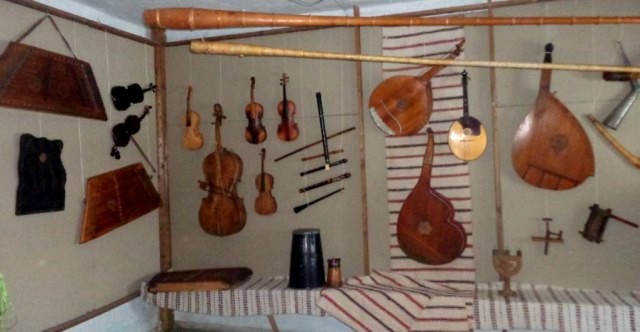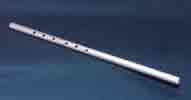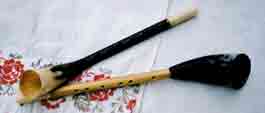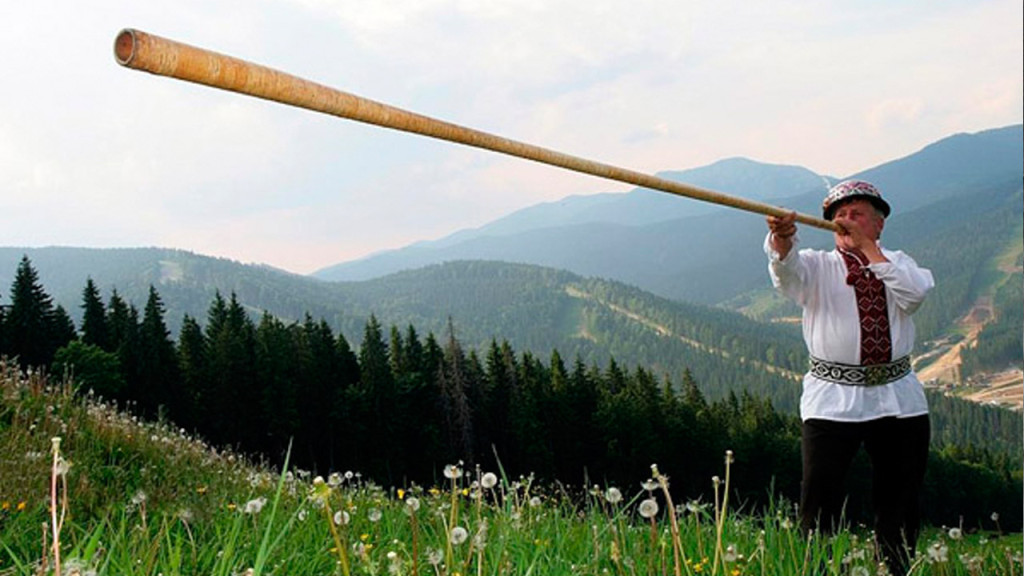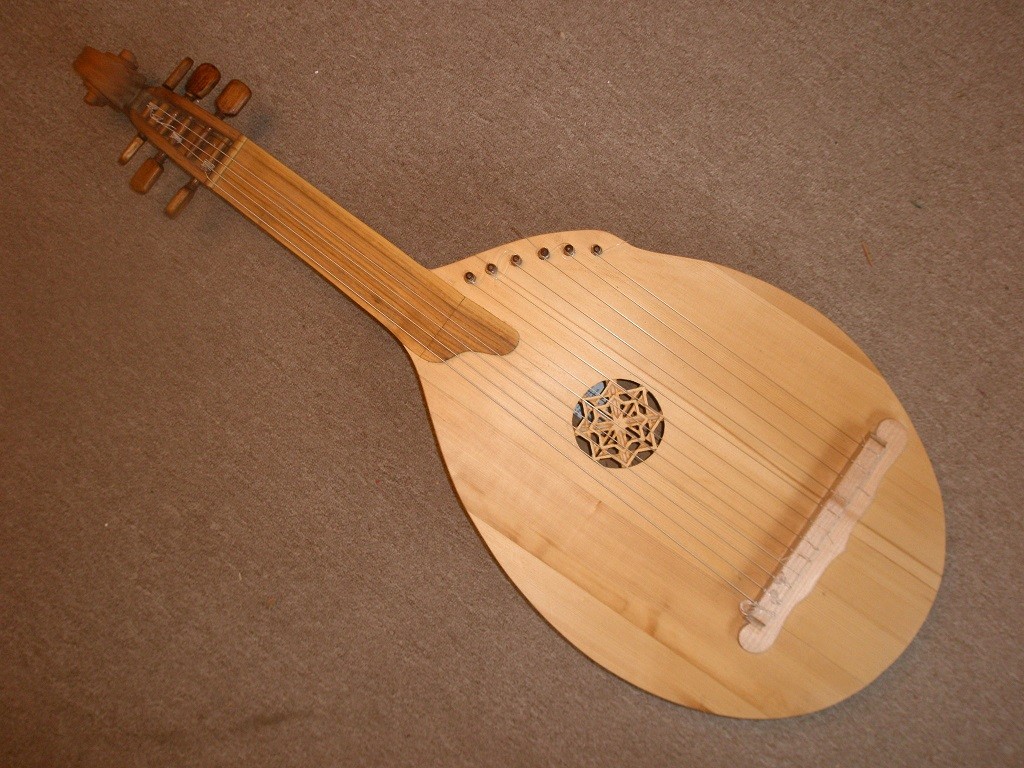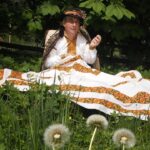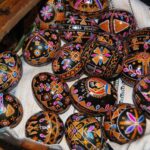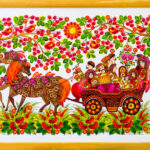Traditional Ukrainian songs are famous all over the world. For many centuries, Ukrainian songs are carrying away people’s minds and souls. An incredible sense and sensibility of melody and lyrics, rich set of instruments create the unique rhythmical structure. Traditional songs have been transferred to every new generation with great honor and pleasure. Starting from early childhood children are brought up in the atmosphere of national art. At kindergartens, schools and institutes children, pupils and students are encouraged to participate in various plays dedicated to Ukrainian traditions, history etc.
You can also check interesting articles on Music at Spriee
Traditional Ukrainian music is predominantly heterephonic: the same melody is distributed among different voice parts, with one leading voice, mostly in a middle register. The lead singer (zaspivoovach) starts singing and determines the course of the melody, and the other voices often come in later. This heterophonic group singing is often embellished by an independent voice in a very high register (vyvodtshyk).
The principle of heterophony allows the principal voice much space for improvisation, continuous variation, and embellishment. It has also an effect on the lyrics, in so far as single words or phrases are lengthened by means of vocalisms or enlarged with additional syllables. This type of choral singing can frequently be found in Central Ukraine, in the steppes and in Eastern Ukraine, where also lyrical ballads are very popular.
The rather comprehensive repertory of Cossack songs and dances has become very famous. This music has its roots in a centuries old oral tradition of bylina (epics, heroic narrative poetry) and dumas, that is long lyrical ballads glorifying the exploits of the Cossacks.
Traditional folk music is the Ukrainians’ life and soul. The songs tell about the history of these people, their characteristics and qualities, about the advantage of this sort of community and about the landscape these people live in. They also speak about the ethics and rules of social life. These songs are a cultural treasure that has been preserved up to date. They can be classified in various genres as well as in ritual and non-ritual songs.
Ritual songs:
1. Incantation
Healing songs sung to earn cure for the ill or in order to influence the weather.
- Laments
Dirges songs
- Ritual songs of the folk calender
– the winter cycle: Kolyadky (Christmas) and Shchedryvky (New Year) are sung by young people visiting the local households and wishing the houseowners happiness and prosperity. Praise of the houseowner determines the biggest part of the texts.
– the spring cycle: Vesnyanky and Hayivky are sung by girls in a circle-dance. There is an element of magic in the ritual songs calling for rain. In early spring (vesna), the vesnyanky are usually sung in an open place at the outskirts of a village. Also musicals and circle dances make up part of the Hayivky (spring games) of the Western Ukraine.
– the festival of earing the grain.
– the festival of threshing the grain.
– pre-harvest: The summer holidays reach their climax with the celebrations for Ivan Kupalo, St John the Baptist and St Peter. The Kupalo ritual closely resembles in meaning and character the “petrivky” songs, performed during a period of two or three weeks before “St Peter’s Day” (29th of June).
– harvest: ritual work songs at the beginning of harvest (zazhynky) and the celebration at its completion (obzhynky) constitute another part of the summer cycle. These songs bring the summer period to an end.
Their original magic meaning was later replaced by social motifs, i.g. the reapers’ hard labour, the relations with their employer or the demands for better wages.
- Wedding songs
– These songs explain what is happening at any given moment during the wedding ceremony; the function of these songs is similiar to incantations – the main theme is about the festive, joyful side of the ritual, and the songs contain also parts of congratulations, or they may even be comic. There is a second kind of wedding songs that are sung at the parting of the bride from the paternal home. They are more lyrical and dramatic and have a looser structure. The wedding party is usually accompanied by a village instrumental trio – troista musyka – a typical and widespread folk music ensemble. The main instruments of this ensemble are the fiddle, the tsimbaly (hammered dulcimer) and the tambourine, and there is often also a pipe.
– The non-ritual wedding songs are sung for entertainment at appropriate times during the celebrations that usually last for one week.
- Work songs
– Vechornyzi (at vechyr, in the evening) are winter evening songs.
This word is not only used for the songs, but it also stands for the young people’s evening meetings as well as for the room, where these meetings take place. Vechornyzi are only sung in the winter period beginning on the 13th of December, the Holy Andrijs Day, and lasting until 7 weeks before Easter with the start of Lent. During this period, young people in the country meet almost every evening after their daily work. They rent a room for their vechornyzi meetings, preferably in the house of a widow or a childless married couple. The girls arrive first and start embroidering shirts (rushnyc). Later, the young men (lads) join them, and they dance and sing together. They do not have to pay money for the rented room, but they bring bread, cereals or linen. Only the drinks at the bar have to be paid in cash.
– Vechornyzi (at vechyr, in the evening) are winter evening songs.
This word is not only used for the songs, but it also stands for the young people’s evening meetings as well as for the room, where these meetings take place. Vechornyzi are only sung in the winter period beginning on the 13th of December, the Holy Andrijs Day, and lasting until 7 weeks before Easter with the start of Lent. During this period, young people in the country meet almost every evening after their daily work. They rent a room for their vechornyzi meetings, preferably in the house of a widow or a childless married couple. The girls arrive first and start embroidering shirts (rushnyc). Later, the young men (lads) join them, and they dance and sing together. They do not have to pay money for the rented room, but they bring bread, cereals or linen. Only the drinks at the bar have to be paid in cash.
– Toloka are sung during or after joint work. In winter, when women meet for spinning, they accompany their work. This kind of song is also sung in other seasons after all kinds of team work (e.g. field work, digging for a well, building a house, repairing streets, etc.). When a farmer has a lot of work to do in the fields, he asks his neighbours for help. After having finished this common work, the farmer invites his neighbours for dinner and then they sing such songs with lyrics that often contain some worldly wisdom.
Non-ritual songs:
– folk epics (duma) or ballads; historical and political songs. The dumy are lengthy lyrical compositions of epic character based on the principles of musical recitation. The rhythms of the ballads’ lyrics are not restricted to metrorhythmic schemas and determine the improvised style of the musical recitation on the basis of variations of typical phrases and verses. The dumy were performed by a soloist called kobzar, because he usually accompanied himself on the kobza (plucked lute), sometimes also on the bandura or the lira. He sung about historical events and events of daily life. The kobzary [plural for kobza], as a rule, were blind.
– Lyric songs can be love songs, songs that tell about family life, or lullabies.
Instrumental music
Archaeologists found a bone flute from the paleolithic age in the Chernovitsy region, and a complex of instruments made of mammoth ivory in Mitsynska village in the Chernigiv region. Pictures of musical instruments exist on frescos in the St. Sophia Cathedral in Kiev and on cheap print “mamay” in the Ukraine.
There are various forms of instrumental folk music in the Ukraine: solo performing on the pipe (flute), violin, bandura, etc. and ensemble playing, for example the traditional musical trio “troyista muzyka“, playing primarily on the occasion of dance events in march processions.
The Hutsuls created a very poetic legend about the formation of the “troyista muzyka” (= music of a trio): Three musicians, a violinist, a cymbal-player and a sopilka-player, fell in love with one maiden. In order to choose her bridegroom, the maiden suggested a contest between the three musicians, and she vowed to marry the one, who was judged the best by the people. So each musician played in turn his favourite melody, but as the three musicians played equally well, none of them could win the contest. Then the maiden made each of them play the same melody, but again, none scored a victory. There was only one thing left to do – to play a tune together. In this way, this music came to be called “troista muzyka“.
There also exists instrumental music which is not played for dances, e.g. the shepherds’ improvisational music played on a violin, a sopilka, a trembita (Ukrainian version of the alphorn, a wooden trumpet, about 3 m long, primarily used in signaling events) or a drymba (jew’s harp). This form of music was usually played on the occasion of weddings or funeral ceremonies. There are also instrumental interpretations of songs like kolyadky (songs of praise) and other Christian carols.
The simplest and earliest forms of instrumental folk musik include signals used in various occupations (to imitate a voice or nature itself) and in ceremonies. The inhabitants of the Carpathian mountains used the trembita in its various forms to inform others about the birth or death of a villager, to signal the return of shepherds back from mountain pastures, and for other important events.
The traditional signals are territorial and form an intricate method of communication. Many of these signals are used by shepherds to note the time to get up, to go to bed, to do the midday milking or to announce the proximity of thieves. Cermonial signals are typically functional in their origin. Viola melodies are played at various parts of a wedding ceremony such as the handing over of the bride, the weaving of the wedding shawls around the arms of the newly weds, and the beginning of the wedding banquet.
At funeral services, special motifs were played to bid farewell to the departed soul. Song forms are usually based on the melody and harmonic basis of the songs accompanied. Some forms require special accompaniment forms such as is the dumy (epic songs) accompanied by the bandura, kobza, or lira.
Traditional styles of instrumental dance music are mostly bound to geographic areas, or they are ethnically defined. So, the kolomya (kolomiyka) belongs to the Ukrainian Carpathians and their neighbouring regions, the hopak and and the kasatchok (cossachok) to the entire Ukrainian ethnic territory, and the polka and waltz belong to the Slavic as well as non-Slavic traditions of the European area. The interaction with Polish, Czech, Slovak and Hungarian folklore in the Western parts (the Carpathians) is revealed in the stabilization of the metrics in comparison with the asymmetrical measures of the eastern lyrics and pronounced functionally harmonic basis of lyric songs. In the south-western part of the Carpathians (Bukovina region), there are resemblances to Moldavian and Romanian instrumental music.
Dance music is an integral part of the instrumental music repertory. In contrast to folksongs, rich in melodies and varied in rhythmical structures, folk dances are mostly in duple time and based on symmetrical musical periods. The principal dances are slowly musically related, and only different accents establish their choreographical characteristics. Dances were usually incoporated into rituals such as weddings and holidays. The Ukrainian have many dances that imitate daily life and works, such as:
– The kolomiyka (Kolomya) has preserved a triplicity of independent forms: song, instrumental piece, and dance. The kolomiyka is danced with choral and instrumental support. Originally it was a Western Ukrainian dance form, with its origins lying in the Carpathians. The lyrics vary greatly, depending on the locality, and are usually in the form of short couplets reflecting everyday activity. kolomiykas have a wide melodic range, intricate syncopated rhythms, and a variety of melisms. Variants of the kolomiyka include the hutsulka (Huzulka), verkhovyna (Werchowina), bukovynka (Bukowina), and arkan.
– The hopak is one of the most popular dances, originally only for men, in which they could show off their prowess, heroism, and manliness. Often during the hopak, a series of spectacular solos by several dancers generates an exciting air of competition. This dance incorporates many acrobatic movements. Variants of the hopak include the zaporozetz, tropak. Hopak melodies may vary in keys but are generally in the major mode. Some hopak melodies are performed entirely without singing and may be performed without any dancing at all.
These dances above are the most prominent folk dances. There exists many other dances such as: kozak, poltavka, hajduk, chaban, and some forgotten dances such as: metelytsia (snowstorm dance) or shunka. Only their melodies are still played, however, dancing to these melodies has come to an end, however, as the dance forms are unknown today.
Instruments from the Ukraine
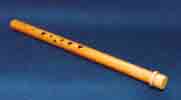 – Sopilka – wind-instrument
– Sopilka – wind-instrument
Ukrainian duct flute, 30-40 cm long, with 6 fingerholes.
The group of flute-like woodwind instruments is in the Ukrainian language generally known as sopilkas. The use of this term, however, has caused much confusion in differentiating the various types of folk wind instruments.
Frilka is a small duct flute with 6 fingerholes made of a 20-50 cm long metal tube.
The frilka is usually smaller than the sopilka and has a higher sound, but its sound is produced in the same manner. It is played by having the breath broken against the side of the pipe.
 – Tylynka – Telenka – wind-instrument
– Tylynka – Telenka – wind-instrument
Large endblown flute without fingerholes made of a 60-80 cm long metal tube.
The sound is changed by placing the finger onto the open end and covering it by a half or third etc. and by the strength of the player’s breath. Its length is approximately 35 to 40 cm, although instruments can range up to 60 cm. This instrument is also found in Romania, especially in the areas bordering with the Bukovina area where it is known as tilinca.
Originally it was made from pussy-willow. It is played by having the breath broken against the side of the pipe.
It is characterized as an open ended notched flute. The pipe is approximately a meter in length. One end is sharpened, and the breath is broken against one of the sides of the tube at the playing end. Six holes in groups of three are burnt out in the center of the instrument. In the Carpathian mountains it was often played at funerals.
There exists a smaller version similar to the sopilka or frilka, approximately 60 cm long. The mouthpiece is sharpened into a cone-like edge, and the instrument produces a sound similar to that of the flute.
Shepherds were also able to accompany themselves with glutteral humming which produced an ostinato tone or drone.
– Surma – Zurna – wind-instrument
Folk oboe of the Arab world, Turkey, Southeast Europe and parts of Asia.
It takes many forms but is most commonly a conical wooden tube with a double reed and usually a piroutte. It is a type of shawm that had widespread use in the Cossack host. It is thought that the instrument was introduced into the Ukraine from the Caucasus. It is also found as “zurna” in the Caucasus (Armenia, Daghestan, Azerbaijan, and to a lesser extent in Georgia).
The surma – zurna is not known in Western Ukrain and in the Ukrainian Carpathians. As in Hungary and in Romania, this instrument was replaced by the clarinet.
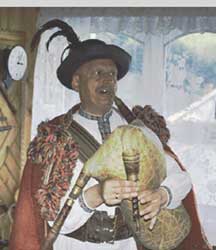 – Bagpipe – Volynka – Duda – wind-instrument
– Bagpipe – Volynka – Duda – wind-instrument
Belongs to the large family of aerophonic instruments which have become a national symbol in Scotland, Ireland and Bulgaria.
The Carpathian bagpipes were used by shepherds, peasants, soldiers, and miners. The instrument has a bag made from goat skin into which air is blown through a pipe with a valve. The main pipe has five to seven, sometimes eight, fingerholes on which the melody is played. The other pipe produces a drone. It is usually either a single tonic note or a perfect fifth. Each of these playing pipes has a double reed usually made from a goose quill.
– Schaléjka – Zhaleika – wind-instrument
(folk clarinet or hornpipe)
Is a folk clarinet with a single reed which may be covered by a mouthpiece (or “wind-cap”). The pipe which is made from wood has finger holes and a flared bell. It can be made of various natural or man-made materials; cow horn bells are common, but all-wood and even birch bark zhaleikas exist, too.
The zhalaika has a diatonic tuning that comes in various keys (G, A, F) and in soprano (i.e. “normal”), alto, and even piccolo forms. They can be tuned by adjusting the reeds. The instrument is normally tuned to the mixolydian mode (which means, in the key of G you get all naturals, no accidentals), and you only get one octave’s worth of notes. You can also get the final non-diminished 7th tone with alternate fingering.
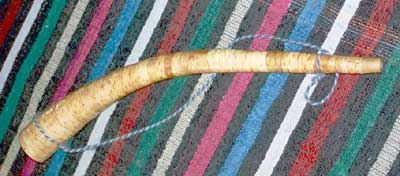 – Rizhok – Signalhorn – wind instrument
– Rizhok – Signalhorn – wind instrument
– Trembita – wind-instrument
The trembita is a Ukrainian version of the alpine horn. Hutsuls play trembitas – tram bratam: “three brothers”. The name goes back to a legend, according to which a magic craftsman made this instrument for three brothers who worked as shepherds. It is made of spruce that has been split, a central bore dug out and then glued together and bound with birch bark. It is usually three meters long, being 2,3 to 5 cm wide at the mouthpiece and 6 cm wide at the bell. Also shorter trembitas of half to one meter in length can be bound. This shorter instrument is often called “vivcharska dudka” (shepherd’s pipe) or “syhnai’na truba“. The mouthpiece is often made from a separate piece. The range is approximately three octaves, encompassing the natural harmonic series such as in the french horns.
There are several kinds of trembitas, and each one with its own special function:
– Small: The koljadyc’ka, less than three meters in length, is used to signal Christmas carolers coming.
– Three meters in length: The vivcars’ka dudka is used by shepherds to signal their location in the mountains, to call the shepherds if the herd is attacked.
– The pochorona, or funeral, is longer than three meters and used for funeral functions.
– The large is played on happy occasions, such as festivals, weddings.
The trembita was primarily used for signalling, such as the coming of visitors, enemies or death in the mountain region, and thus a system of elaborated signals was devised. Carol motifs were also played on the instrument at Christmas. The trembita is not unique to the Ukrainian people, instruments such as the trombita, trabita, and trebita can be found in Poland and the cucium in Romania.
– Bandura (type of psaltery) – string instrument
The Ukrainian bandura is a traditional plucked string instrument that combines the acoustic principles of both the lute and the harp. It is a uniquely Ukrainian instrument with a sound that is empathic and gentle, resembling that of a harpsichord, but with a wider range of dynamics and tonal control. The Ukrainian bandura is thought to have evolved from a line of lute-like instruments, such as its predecessor, the kobza.
The main distingushing characteristics are:
– 1) the absence of frets, which means that each string can sound only one note, as in a harp, and
– 2) the presence of treble strings streched over the soundboard, off center from the bass strings that run along the neck.
The result is an asymmetric body. The once homemade folk instruments have variations in shape.
From the 15th to the 18th centuries, the bandura was played by the kobzari (a kobzar is a wandering minstrel, usually blind and sometimes led by a child), and Kozaks (Cossacks, or free warriors). In the villages and towns, the kobzari sang epic songs (dumy, singular = duma) about the people’s exploits and relations with the Turks and the Tatars, and later about their troubles with the Polish regime. The use and popularitiy of the bandura coincided with the rise of Ukrainian patriotism and nationalism and the subsequent flourishing of the various expressions of art.
Today there are three major types of banduras played in concert:
– the classical or folk bandura, tuned diatonically with 20-24 strings and wooden pegs;
– the Kharkiv bandura, developed by Hnat Khotkevych at the beginning of the 20th century and introduced as an instrument taught at the Kharkiv Conservatory. At first it was tuned diatonically and then developed into a fully chromatic instrument with 34 to 65 strings and three orchestral sizes: piccolo, prima, and bass;
– the Kyiv bandura, also made in several sizes and types.
– Kobza – string-instrument
(lute / psaltery)
The instrument was first noted in a 6th century Greek chronicle in reference to warriors from Ukrainian territories. This instrument was much smaller, more circular and had fewer strings than the modern bandura. With time passing, more strings were added, some of which were strung along the side of the instrument. This made frets along its neck obsolete.
In the 13th century with the migration of a large group of people from Abkhazia to the Poltava region, the term came to differentiate this instrument from other string instruments generally known as “husli“. The kobza became a favourite instrument of the Ukrainian Cossacks and was widely played by the rural population and at the courts of Polish kings and Russian tsars. Here it served a role similar to the lute in Western Europe.
The instrument was traditionally carved out of a single piece of wood and consisted of a soundboard with strings strung across it. The number of strings could vary from three to eight. Occasionally it would have frets made of gut, and three to four additional strings strung along the soundboard. The strings were either plucked with a plectrum or with the ends of the fingers.
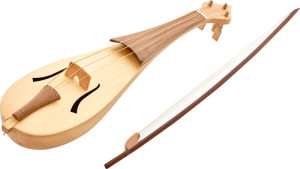 – Rebec / Fiddle – Gudòk – string-instrument
– Rebec / Fiddle – Gudòk – string-instrument
(folk fiddle)
The rebec is a string instrument, the pear-shaped body together wih neck and head of which is fabricated from a single piece of wood. In the Middle Ages it was usually produced three-sided in different sizes and forms, and it was, apart from the “big fiddle” (fiddle), also called small fiddle. In contrast to the fiddle, the rebec is tuned in fifths.
It was the most popular instrument in the Middle Ages. It is depicted in the hands of vagabonds, musicians, and angels. This instrument was often played on the occasion of local festivities and feasts, such as at the court of princes and kings. It has steadily been refined, and from the original spade-like form of the 8th century there has developed the oval form, which is nowadays known for its retracted strings.
From the late Middle Ages on, there has developed a large number of string instruments played with a bow, such as, for example, violins, violas, cellos, etc, which probably have their origin in the fiddle of the Middle Ages.
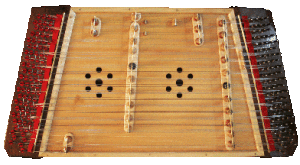 – Tsymbaly – string instrument
– Tsymbaly – string instrument
(hammered dulcimer, cimbalom)
The Ukrainian dulcimer is similar in construction to the husli. It came to the Ukraine through Hungary and Romania. It has a large wooden box with a soundboard on which strings are strung across in courses of three to five strings. Two bridges are placed on the soundboard, over which the strings are stretched. These divide the strings so that each course of strings can produce two different notes. The strings are struck with wooden hammers. Usually the instrument is played in a seated position, placed on the knees of the performer, or in a standing position, with the aid of a long belt that goes around the musican’s neck.
The Ukrainian tsymbaly was chromatizised in the 1950s, and it then had legs and a damper pedal added.
The small tsymbaly are still played and known as Hutsulski tsymbaly (Carpathian region).
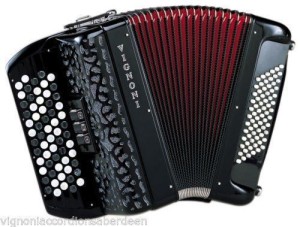 – Accordion – Bayan
– Accordion – Bayan
(button accordion)
Originally the bayan was introduced into the Ukraine from Russia, to where it had been brought from Germany in the 1830ies.
It is now widely used prolifically and has replaced many traditional Ukrainian folk instruments. The bayan can play all notes of the chromatic scale. The buttons are arranged so that each key may be played without changing the stop. The various platelets or reeds which are different in form and material make it possible to produce different sounds for one single tune, and as it is the case with the organ, the air may be distributed in the bayan due to a system of different stops so as to achieve variation in the timbre of sound. These stops are played by means of 16 keys arranged above the right-hand key-board; those which are used most frequently, may also be played with the chin, by means of seven buttons which are situated on top of the instrument.
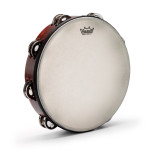 – Tambourine – Buben – percussion instrument
– Tambourine – Buben – percussion instrument
Tambourines, in general, are handheld instruments with a round wooden frame and parchment or skin heads; metal disks or bells (called jingles) are inserted into the wooden rim. By striking the head of the tambourine or by shaking it, the jingles are set in motion.
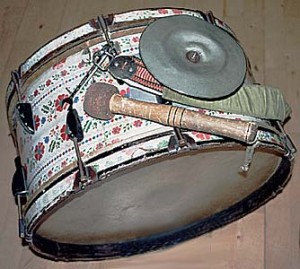 – Bukhalo – percussion instrument
– Bukhalo – percussion instrument
The large drum bukhalo is often used in dance music. It is fixed to the player with a belt so that the performer can also dance and move. The instrument is struck with a stick embedded in wood or metal.


